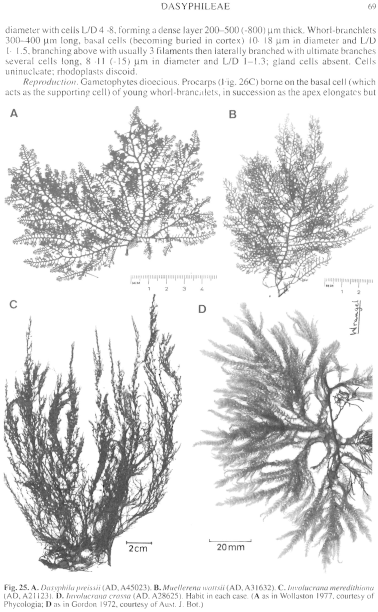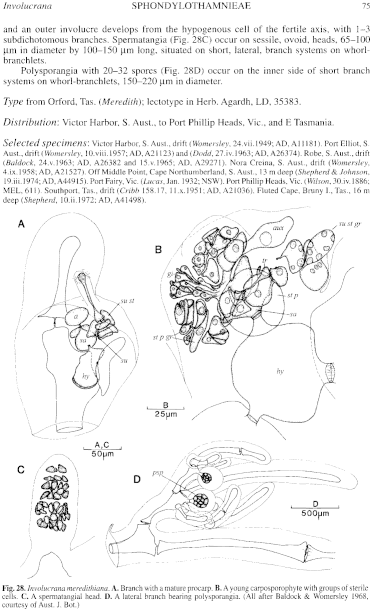|
|
|
|
|
|||||||||||
|
Electronic Flora of South Australia Species Fact Sheet
Phylum Rhodophyta – Order Ceramiales – Family Ceramiaceae – Tribe Sphondylothamnieae
Selected citations: Gordon 1972: 104.
Synonym
Bornetia? meredithiana J. Agardh 1876: 614. Baldock & Womersley 1968: 211, figs 22–35, pl. 4. De Toni 1903: 1297. Guiler 1952: 95. Lucas 1909: 48; 1929a: 24; 1929b: 52. Lucas & Perrin 1947: 328. May 1965: 367. Reinbold 1898: 52. Sonder 1881: 28. Tisdall 1898: 511. Wilson 1892: 170.
Thallus (Fig. 25C) dark red-brown, 5–20 (–25) cm high, much branched with numerous long axes, lower cells of axes 400–500 µm in diameter and 2–4 mm long. Holdfast 2–10 mm across, rhizoidal; epilithic. Structure. Subapical cells forming first a periaxial cell alternately and subdistichously, then a second periaxial cell either unilaterally or suboppositely to the first, and usually a third on the left of the first, forming basally branched whorl-branchlets 5–20 mm long with ultimate branches 4–12 (–14) cells long, median cells 2–4 mm long and 250–400 µm in diameter, terminal cells rounded; indeterminate laterals arising by continued growth of the first formed whorl-branchlets. Cortication by descending and ascending rhizoids, sometimes anastomosing, developed from the lower end of axial cells and basal cell of whorl-branchlets. Cells multinucleate; rhodoplasts discoid to elongate.
Reproduction: Gametophytes dioecious. Female axes of 3 cells (Fig. 28A), arising from the subterminal cell of the first whorl-branchlet, the subapical cell producing 2 pericentral cells, the abaxial one being the supporting cell cutting off a sterile apical cell and a 4-celled carpogonial branch; fusion cell large, irregularly lobed, with terminal clavate carposporangia 45–90 µm in diameter, closely attached to the fusion cell; carposporophyte (Fig. 28B) 450–900 µm across; the apical cell, the sterile pericentral cell and the sterile cell on the supporting cell all divide post-fertilization to form an inner involucre of 3-celled, incurved, branches, and an outer involucre develops from the hypogenous cell of the fertile axis, with 1–3 subdichotomous branches. Spermatangia (Fig. 28C) occur on sessile, ovoid, heads, 65–100 in diameter by 100–150 µm long, situated on short, lateral, branch systems on whorl-branchlets.
Polysporangia with 20–32 spores (Fig. 28D) occur on the inner side of short branch systems on whorl-branchlets, 150–220 in diameter.
Type from Orford, Tas. (Meredith); lectotype in Herb. Agardh, LD, 35383.
Selected specimens: Victor Harbor, S. Aust., drift ( Womersley, 24. vi i .1949 ; AD, A11181). Port Elliot, S. Aust., drift (Womersley, 10.viii.1957; AD, A21123) and (Dodd, 27.iv.1963; AD, A26374). Robe, S. Aust., drift (Baldock, 24.v.1963; AD, A26382 and 15.v.1965; AD, A29271). Nora Creina, S. Aust., drift (Womersley, 4.ix.1958; AD, A21527). Off Middle Point, Cape Northumberland, S. Aust., 13 m deep (Shepherd & Johnson, 19.iii.1974; AD, A44915). Port Fairy, Vic. (Lucas, Jan. 1932; NSW). Port Phillip Heads, Vic. (Wilson, 30.iv.1886; MEL, 611). Southport, Tas., drift (Cribb 158.17, 11.x.1951; AD, A21036). Fluted Cape, Bruny I., Tas., 16 m deep (Shepherd, 10.ii.1972; AD, A41498).
Distribution: Victor Harbor, S. Aust., to Port Phillip Heads, Vic., and E Tasmania.
Taxonomic notes: I. meredithiana is a deep water species, often common on south-east coasts of South Australia.
References:
AGARDH, J.G. (1876). Species Genera et Ordines Algarum. Vol. 3, Part 1- Epicrisis systematic Floridearum, pp. i-vii, 1–724. (Weigel: Leipzig.)
BALDOCK, R.N. & WOMERSLEY, H.B.S. (1968). The genus Bornetia (Rhodophyta, Ceramiaceae) and its southern Australian representatives, with a description of Involucrana gen. nov. Aust. J. Bot. 16, 197–216, Plates 1–4.
DE TONI, G.B. (1903). Sylloge Algarum omnium hucusque Cognitarum. Vol. 4. Florideae. Sect. 3, pp. 775–1521 + 1523–1525. (Padua.)
GORDON, E.M. (1972). Comparative morphology and taxonomy of the Wrangelieae, Sphondylothamnieae and Spermothamnieae (Ceramiaceae, Rhodophyta). Aust. J. Bot. suppl. 4, 1–180.
GUILER, E.R. (1952). The marine algae of Tasmania. Checklist with localities. Pap. Proc. R. Soc. Tasmania 86, 71–106.
LUCAS, A.H.S. & PERRIN, F. (1947). The Seaweeds of South Australia. Part 2. The Red Seaweeds. (Govt Printer: Adelaide.)
LUCAS, A.H.S. (1909). Revised list of the Fucoideae and Florideae of Australia. Proc. Linn. Soc. N.S.W. 34, 9–60.
LUCAS, A.H.S. (1929a). The marine algae of Tasmania. Pap. Proc. R. Soc. Tasm. 1928, 6–27.
LUCAS, A.H.S. (1929b). A census of the marine algae of South Australia. Trans. R. Soc. S. Aust. 53, 45–53.
MAY, V. (1965). A census and key to the species of Rhodophyceae (red algae) recorded from Australia. Contr. N.S.W. natn. Herb. 3, 349–429.
REINBOLD, T. (1898). Die Algen der Lacepede und Guichen Bay (Slid Australien) und deren näherer Umgebung, gesammelt von Dr. A. Engelhart-Kingston. II. Nuova Notarisia 9, 33–54.
SONDER, O.W. (1881). In Mueller, F., Fragmenta Phytographiae Australiae. Supplementum ad volumen undecinum: Algae Australianae hactenus cognitae, pp. 1–42, 105–107. (Melbourne.)
TISDALL, H.T. (1898). The algae of Victoria. Rep. 7th Meet. Aust. Ass. Adv. Sci., Sydney, 1898, pp. 493–516.
WILSON, J.B. (1892). Catalogue of algae collected at or near Port Phillip Heads and Western Port. Proc. R. Soc. Vict. 4, 157–190.
The Marine Benthic Flora of Southern Australia Part IIIC complete list of references.
Publication:
Womersley, H.B.S. (24 December, 1998)
The Marine Benthic Flora of Southern Australia
Rhodophyta. Part IIIC. Ceramiales – Ceramiaceae, Dasyaceae
©State Herbarium of South Australia, Government of South Australia
Illustrations in Womersley Part IIIA, 1998: FIGS 25C, 28.

Figure 25 enlarge
Fig. 25. A. Dasyphila preissii (AD, A45023). B. Muellerena wattsii (AD, A31632). C. Involucrana meredithiana (AD, A21123). D. Involucrana crassa (AD, A28625). Habit in each case. (A as in Wollaston 1977, courtesy of Phycologia; D as in Gordon 1972, courtesy of Aust. J. Bot.)

Figure 28 enlarge
Fig. 28. Involucrana meredithiana. A. Branch with a mature procarp. B. A young carposporophyte with groups of sterile cells. C. A spermatangial head. D. A lateral branch bearing polysporangia. (All after Baldock & Womersley 1968, courtesy of Aust. J. Bot.)

|
Email Contact: State Herbarium of South Australia |

|